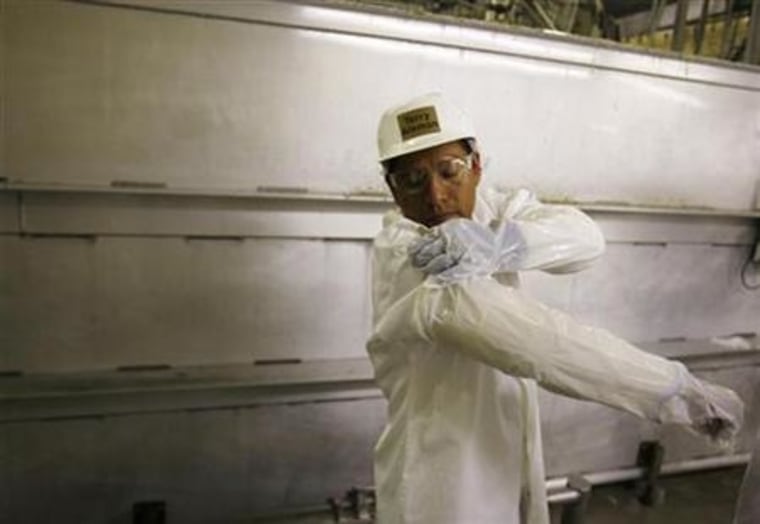The Hispanic population in this small town in eastern Iowa has surged in recent years as immigrants from Latin America have come to work in a local turkey slaughterhouse.
In 2010, the town's many Hispanic residents officially grew to 52 percent of West Liberty's population, according to the U.S. Census. That made the town of 3,700 people the first white-minority community this overwhelmingly Caucasian state has seen in nearly 100 years.
Yet while immigration-driven demographic change elsewhere in the country has often sparked fear and reaction, residents say the transformation has occurred relatively amicably, without triggering the concern and punitive policy-making seen in places like Arizona and Indiana.
"The people are united in West Liberty," said Cruz Martinez, 42, who grew up in town and now volunteers at the Diversity Service Center Of Iowa in nearby Muscatine, which advocates on behalf of immigrants.
"I've always felt that."
Signs of the presence -- and purchasing power -- of the town's new majority abound. Along the small main drag in downtown West Liberty, the tienda and the tacqueria sit comfortably alongside the feed store and the Strand Theater.
At the BP service station on North Columbus, the road connecting West Liberty to Interstate 80, the convenience store's beer specials are advertised mostly in Spanish.
"This is home," said Francisco Martinez, a 40-year-old slaughterhouse worker who has lived in West Liberty for 15 years and has two children in its public schools.
"It's a peaceful, quiet, friendly town. People leave each other alone."
Darel Sterner, 80, used to run a barbershop on the corner of Third and Spencer in downtown West Liberty until 1995, when Mexican investors bought his building and he decided to go into semi-retirement.
Sixteen years later, Sterner still cuts hair in a shop he set up in his basement, and he says Hispanic residents are among those who come for a trim and shave.
"They're good customers," he said.
One sign of West Liberty's embrace of its demographic, cultural and linguistic shift is the popularity of the Dual Language Program in its public schools, which is offered from pre-kindergarten through the 12th grade.
Students enrolled in the voluntary program, now in its 13th year, are taught in English half of every school day and in Spanish the other half.
The point of the program, administrators say, is not only to make students bilingual, bi-literate and bicultural -- but to make West Liberty a place where assimilation is a two-way street.
Occasional tensions
The program has even drawn a small influx of young, non-Hispanic families back into West Liberty, led by parents like Richard and Linley Heath, who believe fluency in more than one language can open opportunities for their three sons.
In recent years, even as school budgets have come under pressure, West Liberty's Dual Language Program has remained fully funded.
"That's due to the leadership of the town, the churches and businesses," said Rosa Mendoza, 51, an executive with the Diversity Service Center Of Iowa.
To be sure, the changes in West Liberty have not come without occasional tensions, some of which linger.
Many Hispanics complain some police departments in nearby counties engage in racial profiling, pulling over people guilty of doing nothing more than "driving while brown," said Oscar Garcia, a 57-year-old former corrections officer from Muscatine who now works with autistic children in West Liberty.
Some whites, meanwhile, still grumble openly about the immigrants, some of whom have limited English skills even after living in the town for decades.
A new subdivision on the outskirts of town suggests some whites are moving away from the city center, where the cultural influence of the Hispanic population has rapidly grown. An anti-immigrant rant scratched on the bathroom door of the BP station hints at anxiety felt by some who can't move away.
But overall, Hispanic residents say they feel welcomed, understood and valued in West Liberty -- though politically they remain outsiders with control of the city council and the board of education firmly in white hands.
"The community itself - the relationship between the Anglos and the Hispanics -- is great," said Garcia.
"The average Anglo here has no problem with us and we have no problem with them."
The accommodation that has apparently been reached in West Liberty ultimately just makes economic sense, says Rene Rocha, a political scientist at the University of Iowa.
While true integration may take time in small towns like West Liberty, economic integration in these unusual diverse rural communities happens very quickly.
For proof of that, Rocha points to the example provided by Postville, Iowa -- a historically white town whose ethnic composition changed rapidly as its biggest employer, a meat-packing plant, relied more and more on Hispanic labor.
In 2008, immigration agents swooped down on Postville, arresting one-in-five residents and ultimately deporting several hundred of them.
"The raids just decimated the town," Rocha said, and served as a stark lesson to other small towns with big immigrant populations how important those communities are to the health of the whole.
"Once the Latinos were driven out of the town, landlords didn't have tenants, restaurants didn't have customers ... The consequences were quite dramatic."
